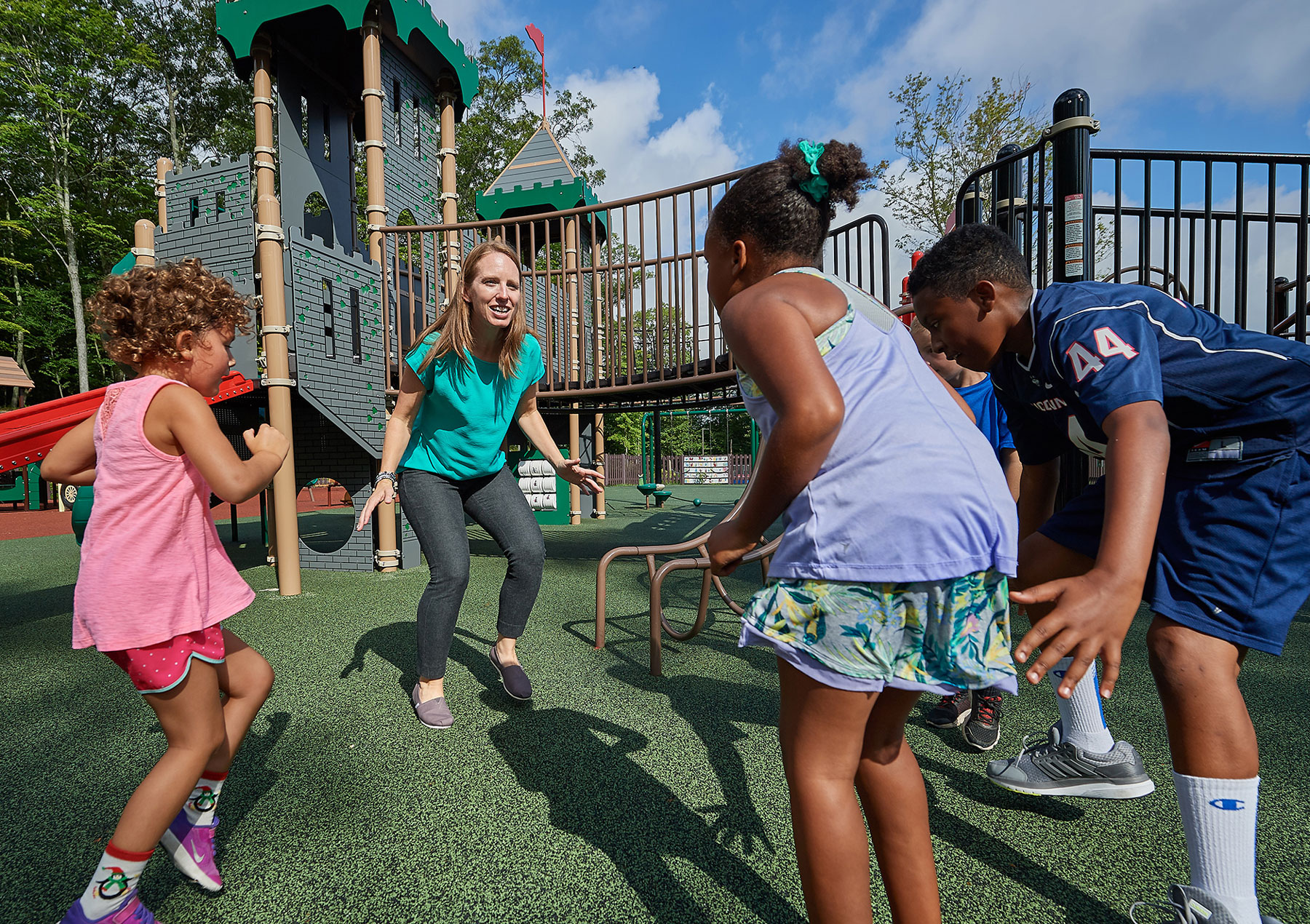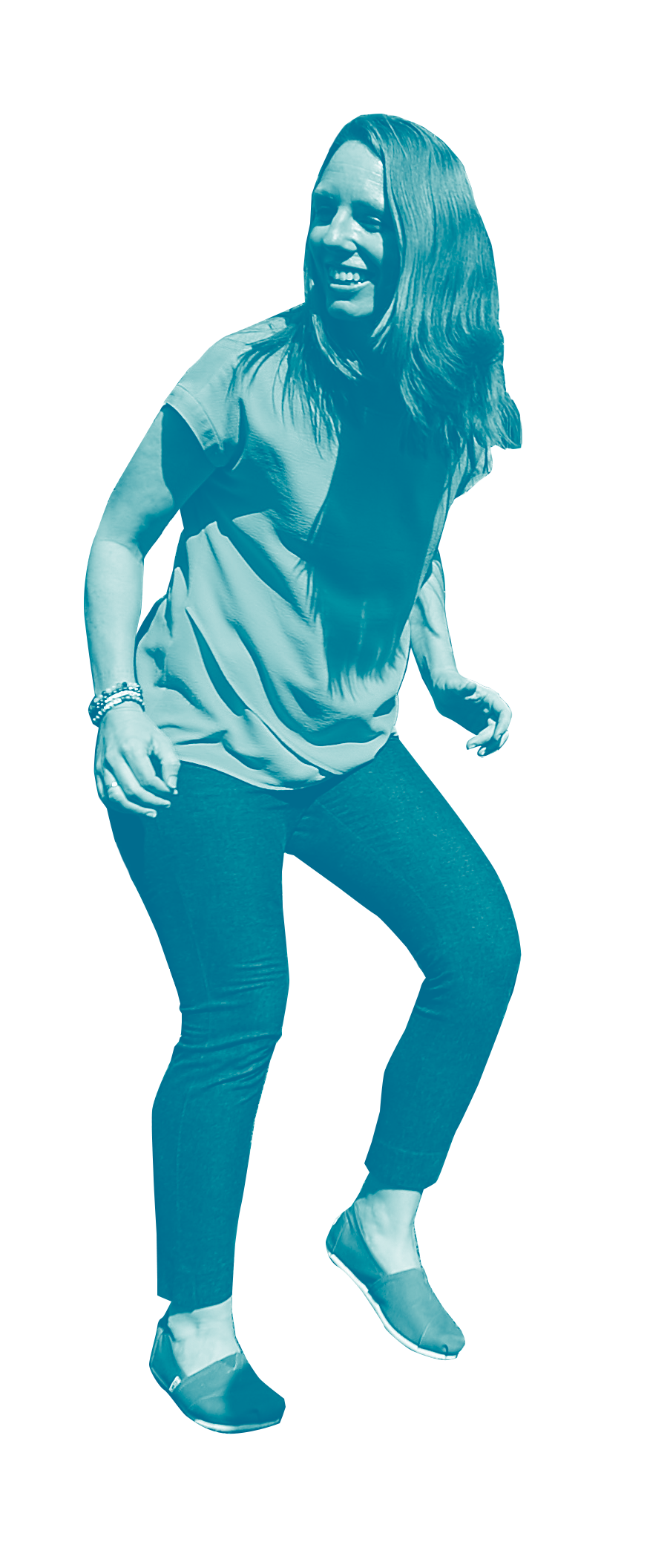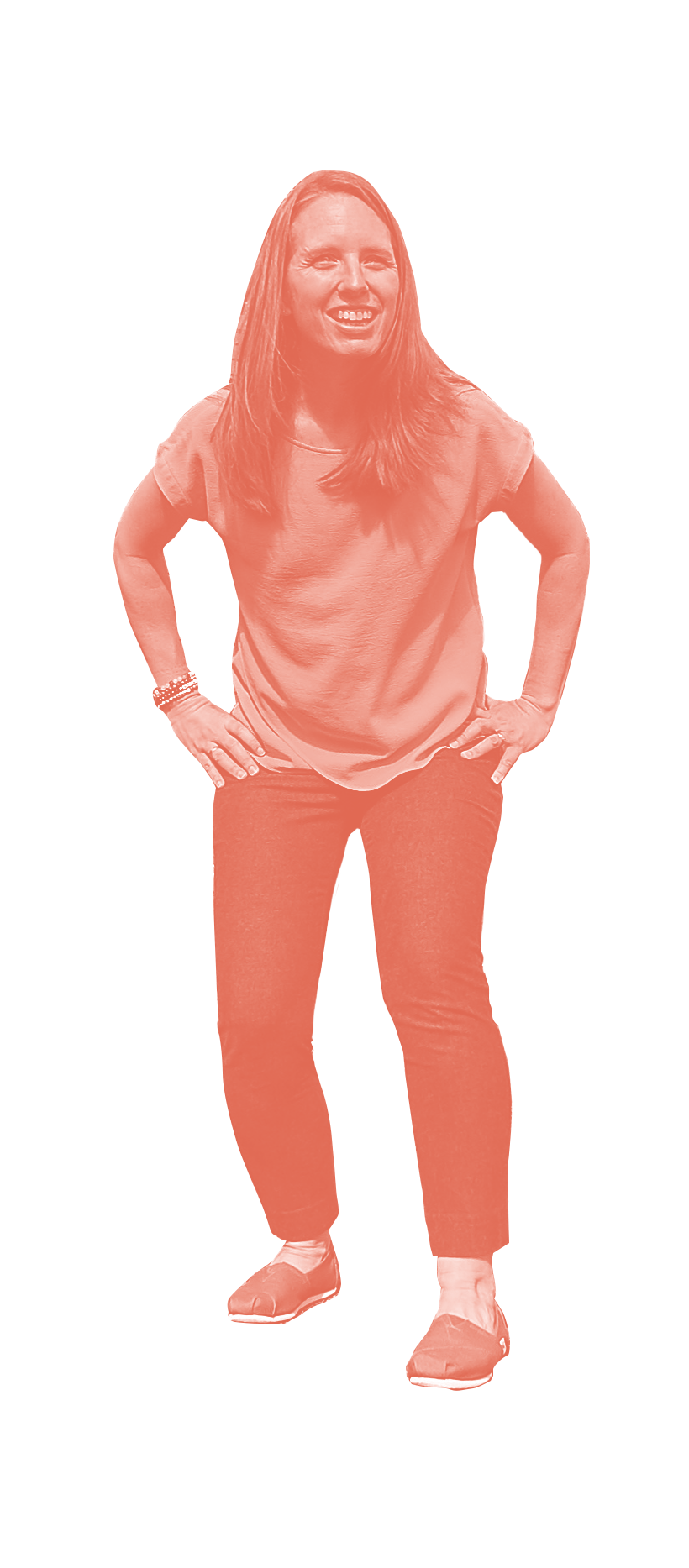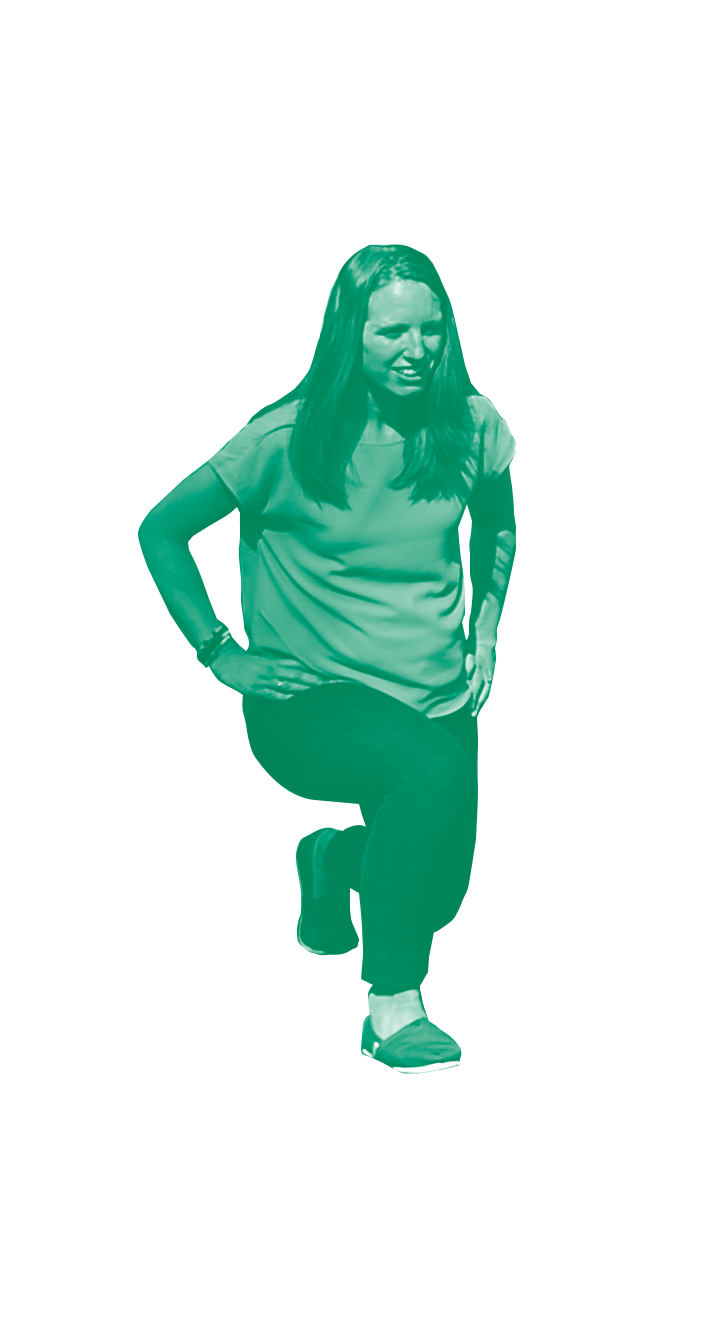The Fight for
Physical Literacy
Elementary schools are associate professor Lindsay DiStefano's battleground. "Move!" Is her rallying cry.
By Elaina Hancock '09 MS
Photos by Peter Morenus

The Fight for
Physical Literacy
Elementary schools are associate professor Lindsay DiStefano's battleground. "Move!" Is her rallying cry.
By Elaina Hancock '09 MS
Photos by Peter Morenus

Spend any amount of time around kids and it quickly becomes evident that they need to move. Running, jumping, and dancing are not just outlets for the limitless childhood energy we wish we could bottle up and use as adults — they are another form of literacy, says Lindsay DiStefano, an associate professor in kinesiology at UConn. Just as with reading literacy, she says, a strong early foundation in physical literacy will have lifetime benefits. Studies show that developing a good sense of balance, for example, can cut the risk of ankle and lower-leg injuries by half.
Much of DiStefano's research these days is focused on measuring the benefits of activity breaks for elementary school students. Schools across the country are facing budget choices that result in cuts to physical education programs and decreased recess time.
In the same vein as "sitting is the new smoking," this trend of shortening recess and cutting physical education opportunities in today's schools is doing a disservice to children far beyond just keeping them at the desk when they could be moving.
A recent study published in The Journal of Pediatrics showed that more physical activity for school-age kids resulted in improvements in behavior and academics, namely in math and reading skills. The National Association of Physical Literacy (NAPL) states that 87 percent of students who practice physical literacy day to day are more successful academically, are more comfortable in social situations, and are happier overall. This is a message DiStefano, who serves on the NAPL advisory board, is eager to get out.
Using lesson plans or resources available online, such as the GoNoodle exercise videos, DiStefano and her students have been working with Jennifer McGarry and the Husky Sport program to get school kids moving.
"In general, physical literacy is just like learning to read," says DiStefano. "Gaining reading literacy is important for kids in order to succeed throughout their education. Physical literacy is important for children to develop in order for them to be physically active for a lifetime."
"Gaining reading literacy is important for kids in order to succeed throughout their education. Physical literacy is important for children to develop in order for them to be physically active for a lifetime."

Q:Â What is physical literacy?
A:Â The definition being adopted in the U.S. is the ability, confidence, and desire to be active. If kids don't have foundational physical skills, if they don't know how to do the basics like jump properly, they won't feel confident being active and will be less likely to participate in physical activities in the future.
Q:Â Â You studied sports medicine in undergrad and grad school at Boston University and then UNC-Chapel Hill. How did you get from there to researching physical literacy in young children?
A:Â My research background in sports medicine started specifically with identifying and correcting risk factors for common injuries. I saw that a lot of what we consider today as risk factors for injury are actually related to children not learning normal motor control. If a child isn't given adequate physical opportunities and experience, there's a risk that they will not know how to control their body correctly when they try to play a sport as an adult, which may be setting them up for the risk of injury. And they will be less likely to participate in physical activity across their lifetime.
Q:Â Â So how do we fix that?
A:Â The best way to reach every child is through school. A big component is getting teachers to incorporate physical activities into the classroom experience. This gives teachers the opportunity to help children learn how to control their body and be exposed to different types of movement. And classroom-based physical activity breaks have been shown to improve student attention, behavior, and academic performance. This is really a win-win for teachers and students.
Q:Â Â How much of an activity break is enough to yield positive effects?
A:Â The longer the better, however there have been studies done that show even a five- minute break can give kids an effective dose of activity. So if they had two five-minute breaks a day, that's an extra 50 minutes of physical activity they are getting over the course of a week, and that makes a big difference.
Kids should be getting at least 60 minutes of physical activity per day. Even better, if they got five minutes every hour throughout the school day, that would give children roughly an extra 30 minutes per day, so that would be huge when you think about children's overall physical activity levels in our country.
Basically the message is just do something. I think a lot of teachers, when you ask them to do a five-minute break each hour, that might seem a little too daunting, whereas if you say just try at least once a day, give these kids five to ten minutes, that seems like a good place to start.
Q:Â Why is it so important to start young? Is it too late for older children or adults to improve their physical literacy?
A:Â There have been a lot of studies that show that just 10 minutes of active warm-up prior to a game or practice — those exercises that emphasize balance, flexibility, agility, strengthening, and plyometrics — can substantially reduce the risk of sport-related injury.
But we also know that it's substantially harder for an adult to learn a new task than for a child. Mature motor development happens between 10 and 12 years of age. This is where we believe the push should really be made, in elementary and middle school children, because at these ages they should have the ability to improve much easier and much faster.
"A lot of my research centers on preventing any injuries from happening, because once you sustain one injury, you're more likely to sustain more."

Q:Â Â What would you say are the main enemies of physical literacy today?
A:Â Cutting back on recess, cutting back on physical education activity, lack of free play, more video games, and families not having as much time to enjoy physical activity together. All of these are big factors that decrease physical literacy. Also, adults are role models for activity. Low levels of adult physical activity in this country is also hurting the children.
Q:Â Â When you say that physical literacy decreases the chance of injury, what kinds of injuries can be reduced?
A:Â A lot of lower-body injuries, knee pain, ACL injuries, and stress fractures; they share common risk factors. Activities to reduce any one injury will reduce all of those injuries. Basically a lot of those injuries happen because an athlete or child does not know how to properly control their body during fastpaced movement and so they load their joints improperly. A lot of my research centers on preventing any injuries from happening, because once you sustain one injury, you're more likely to sustain more.
Q:Â Â Did that happen to you?
A:Â I grew up playing soccer and ice hockey. I played hockey at BU and had seven different orthopedic surgeries: shoulder, knee, ankle, wrist, hands. But I worked with great athletic trainers to help me return to play. Because of an injury my senior year at BU, I got to work closely with a fantastic orthopedic surgeon who was actively engaged in research — and that's how I got the research bug.
Q:Â Â Do you still play ice hockey?
A:Â Now I just play sports for fun with my kids, and I coach youth hockey. I've got three little kids, so I have that motivation to ensure that they and their peers grow up and know how critical moving throughout their lives can be. All of my kids' teams do preventive training and we've started evaluating kids for physical literacy. It definitely helps communicating with the parents of athletes that I coach now.
Q:Â Â You're an advocate of sports sampling. What is that?
A:Â It's much easier to learn movement control if children are exposed to a lot of different types of movement activity. Therefore it's important to sample a lot of different sports, aka "sports sampling."
If you hear, "I don't like sports" or "I don't like basketball," well, have you tried different activities? Have you tried one of the 100 other options? If children try a lot of different types of activities, it is more likely they will find something they're really passionate about. It also means they will learn a lot of different types of movement and body control. So controlling objects with the upper body — hitting and striking, using the lower body — kicking or controlling an object with the feet — different types of activities control different aspects of the body.
Q:Â Â How do you counsel parents on sports specialization, something we are hearing so much about these days?
A:Â Sports specialization is the opposite of sports sampling. Basically it is when a child starts to only play one sport for the majority of the year at the expense of playing other sports. Frequently it happens when athletes demonstrate some talent and their coaches or parents start to think they are likely to get a scholarship or play professionally, so they end up playing that sport year-round.
When kids start specializing before the age of 12, they tend to get burned out or hurt. A good rule of thumb is to ensure your child is active 60 minutes a day, one sport per season, a different sport every season. Kids can go outside and play all they want, but should have no more hours per week of organized activity than their age, so a 9-year-old should not be doing more than nine hours of organized physical activity per week.
The goal is for children to improve their physical activity participation, and it's not as simple as creating opportunities for them. We need to do a better job of ensuring that kids have developed the skills and desire to be active, so they can be safe while they are active and so they can stay active for life.

I agree wholeheartedly – children need more movement! I squeeze in movement whenever I can, but time is tight. Most teachers know what’s good for children, but the powers that be don’t seem to have a clue! When pressure to perform well on high-stakes testing (as well as multiple district benchmark assessments) is alleviated, I think you’ll see more teachers jumping on the physical literacy bandwagon – it’s fun for us, too!
The sports sampling idea is wonderful. Our PE teacher has created a curriculum that the students LOVE and it’s all about teaching different skills in fun ways. And GoNoodle – is a sanity saver!
DiStefano is on the right track encouraging families to take more responsibility for physical literacy – home is where it all begins!
There has been a lot of focus in my district on social-emotional health as well, including suicide prevention. I am waiting for the realization to dawn on folks that maybe if we focus on developmentally appropriate practices that include play, music, movement, art, etc.., instead of pushing students to master content that they are not developmentally ready to learn, we might end up with well-rounded (socially, emotionally, physically, and mentally), adults.